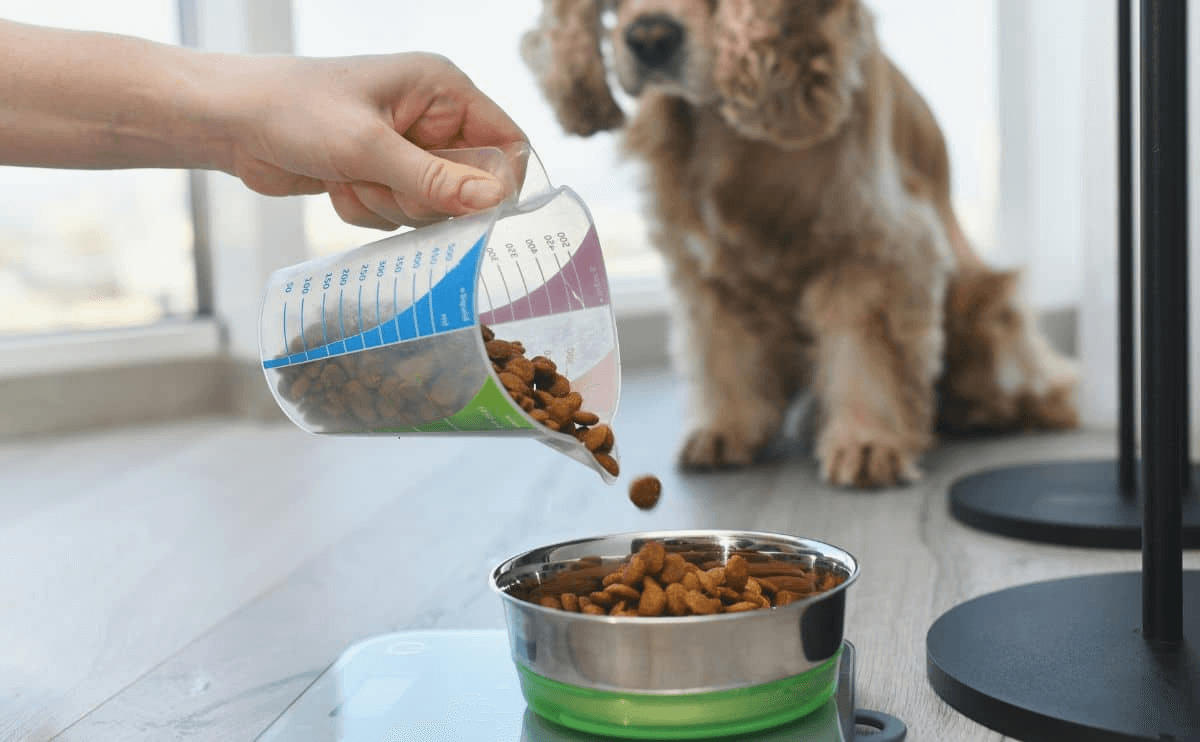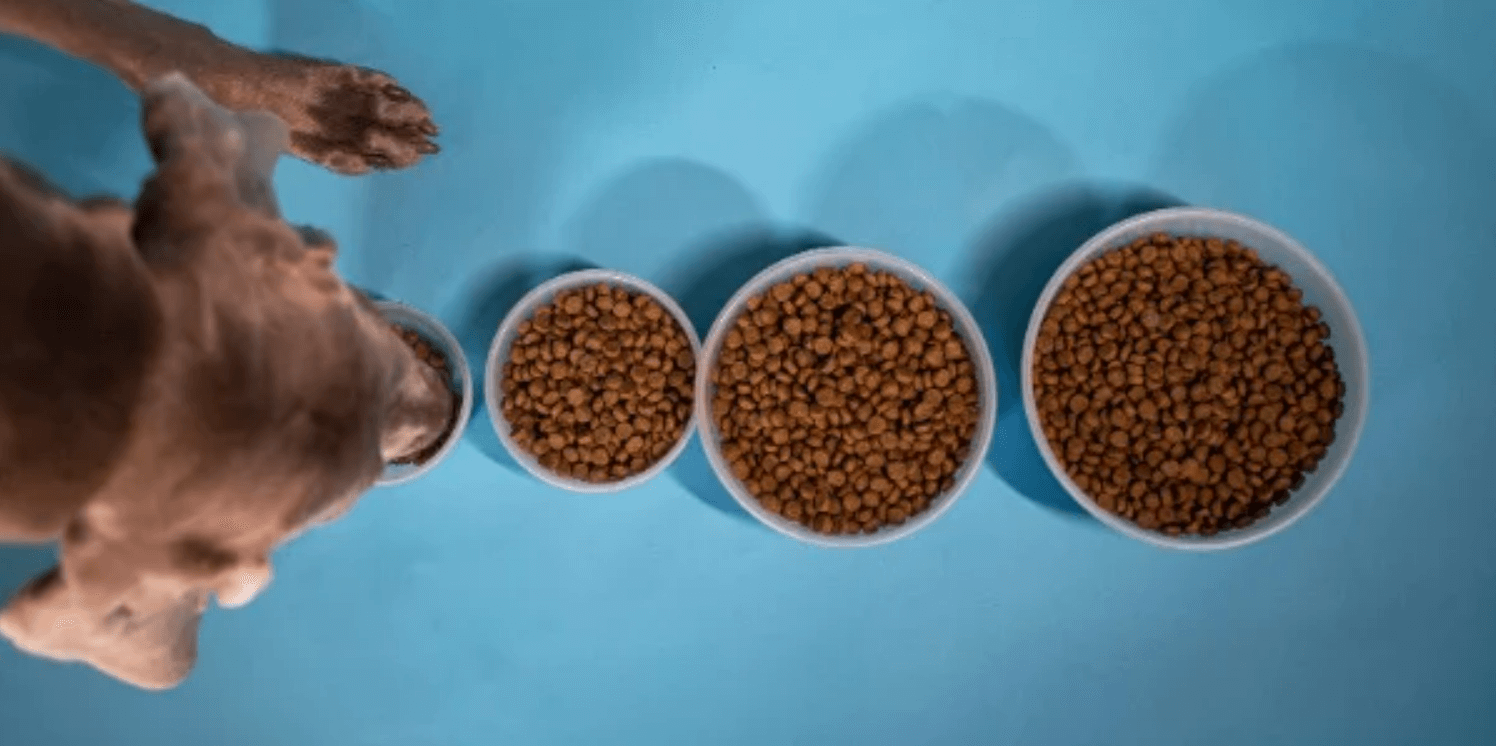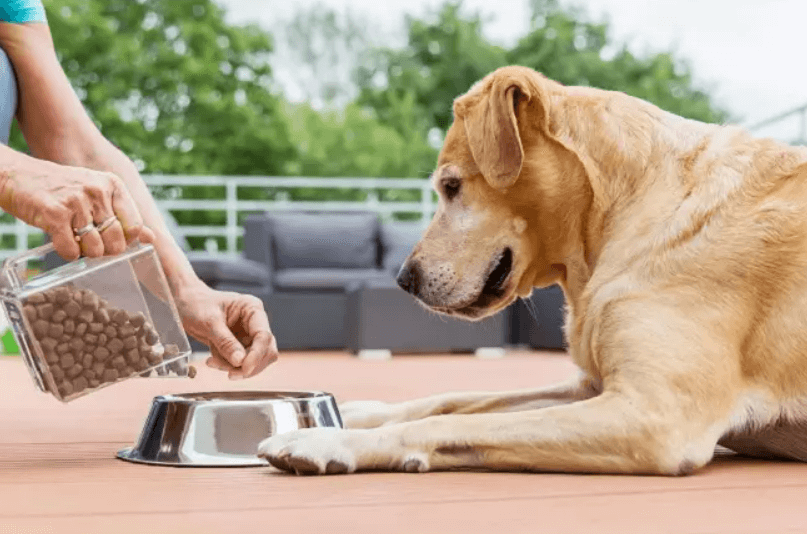Understanding the appropriate portion for your dog food is crucial for their nutrition and overall well-being. In this article, we will learn how many cups of dog food in a pound and explore ways to simplify feeding by determining the right measurement for your furry friend’s dietary needs.
Let’s reading!
How Many Cups Of Dog Food In A Pound?
There are over 3 cups of dog food in a pound bag. As a general guideline, 5 ounces of dog chow fits into a cup. The equivalent is little more than 3 cups of dog chow per pound.
To ensure accurate portioning, it’s recommended to refer to the specific feeding guidelines provided by the dog food manufacturer bag.
Additionally, consulting with your veterinarian can help determine the appropriate portion sizes based on your dog’s specific needs and activity level.

How To Know The Amount Of Food Should Give Your Dog?
Let’s learn 5 factors that should be considered to ensure proper portioning and prevent overfeeding or underfeeding.
Consider your dog’s individual needs
Factors such as metabolism, breed, body condition, and health conditions can affect their dietary requirements. For example, a puppy might need to feed smaller dry food than adult dogs. Take time to look into the best dry food for your dog to pick the perfect one for your furry friend.
Besides, contact with your veterinarian to determine the ideal portion size based on your dog’s specific needs.
Monitor your dog’s body condition
As mentioned above, regularly assess your dog’s body condition to ensure they maintain a healthy weight and dietary requirements. For example, if they are gaining or losing weight, adjust the portion size accordingly.
Adjust for activity level
Dogs with higher activity levels may consume more dry dog food to meet their energy needs. If your dog is highly active, consider increasing their portion size to accommodate their activity level. Similarly, less active dogs may require smaller portions to prevent weight gain.
Consider the calorie density of the food
Different dog food brands and formulas have varying calorie densities. Be mindful of the calorie content per cup or per weight of the food. This information can help you calculate the appropriate portion size based on your dog’s caloric requirements.

Dog feeding chart (in cups)
| Dog Size | Weight | 6-12 Weeks | 3-4 Months | 5-7 Months | 8-12 Months | Adult |
| Toy | 3-5 lbs. | 1 ¼-1 ½ | 3/4 – 1 ½ | 2/3 – 1 ½ | 1/2 – 3/4 | 1/2 – 1/4 |
| Toy | 5-10 lbs. | 1 ½ – 2 ⅔ | 1 ¼ – 2 ¼ | 1 – 1 ⅔ | 3/4 – 1 ¼ | 3/4 – 1 ¼ |
| Small | 10-20 lbs. | 2 ⅔ – 4 ⅓ | 2 ¼- 3 ½ | 1 ⅔ – 2 ¾ | 1 ¼ – 2 ¼ | 1 ¼ – 1 ¾ |
| Small | 20-30 lbs. | 4 ⅓ – 6 | 3 ½ – 4 ¾ | 2 ¾ – 3 ¾ | 2 ¼ – 2 ¾ | 1 ⅓ – 2 ⅓ |
| Medium | 30-40 lbs. | 6 – 7 ⅓ | 4 ⅓ – 6 | 3 ¾ – 4 ¾ | 2 ¾ – 3 ½ | 2 ⅓ – 3 |
| Medium | 40-60 lbs. | 7 ⅓ – 10 ¼ | 6 – 8 ¼ | 4 ¾ – 6 ⅓ | 3 ½ – 4 ¾ | 3 – 4 |
| Large | 60-80 lbs. | 7 ⅓ – 10 ¼ | 8 ¼ – 10 | 8 – 9 ⅓ | 4 ¾ – 6 | 4-5 |
| Large | 80-100 lbs. | 7 ⅓ – 10 ¼ | 8 ¼ – 10 | 8 – 9 ⅓ | 6 – 7 ¼ | 5-5 ¾ |
| Extra Large | 100-125 lbs. | 7 ⅓– 10 ¼ | 8 ¼ – 10 | 8 – 9 ⅓ | 7 ¼ – 8 ⅓ | 5 ¾ – 7 |
| Extra Large | 125-150 lbs. | 7 ⅓– 10 ¼ | 8 ¼ – 10 | 8 – 9 ⅓ | 8 ⅓ – 9 ½ | 7-8 |
| Extra Large | 150+ lbs. | 7 ⅓– 10 ¼ | 8 ¼ – 10 | 8 – 9 ⅓ | 9 ½ – 10 ¾ | 8-9 |
It’s important to remember that these are general guidelines and may need to be adjusted based on factors such as the dog’s age, breed, metabolism, and activity level.
It’s also recommended to divide the daily portion into multiple meals throughout the day for better digestion and to prevent overeating.

What Are Tips For Portioning Dog Food Effortlessly?
By following these tips, you can make the process of portioning dog food reasonable and accurate.
- Use a measuring cup or scale: Buying a measuring cup or digital kitchen scale to accurately measure the appropriate amount of dog food. This ensures consistency in portion sizes and prevents over or underfeeding.
- Follow the feeding guidelines: Consult the feeding guidelines provided by the dog food manufacturer on bags. These guidelines are typically based on factors like your dog’s weight, age, and activity level. Use them as a starting point and adjust as needed to meet your dog’s specific dietary needs.
- Monitor treats and extras: Keep track of the treats and extras you feed your dog throughout the day. These additional calories can add up quickly and affect a dog’s overall calorie intake.
- Mealtime routine: Establish a consistent mealtime routine for your dog at home. Feed meals at regular intervals and avoid leaving food out all day. This helps in controlling portion sizes and prevents overeating.
- Avoid free-feeding: Free-feeding, where food is available at all times, can lead to overeating and weight gain. Instead, provide measured portions at designated meal times.
In Short
Knowing how many cups of dog food are in a pound bag can greatly simplify the feeding process and ensure your dog receives the appropriate amount of dry dog food. By understanding this measurement, you can easily manage portion control and provide your furry companion with a well-balanced diet for their optimal health and nutrition.
